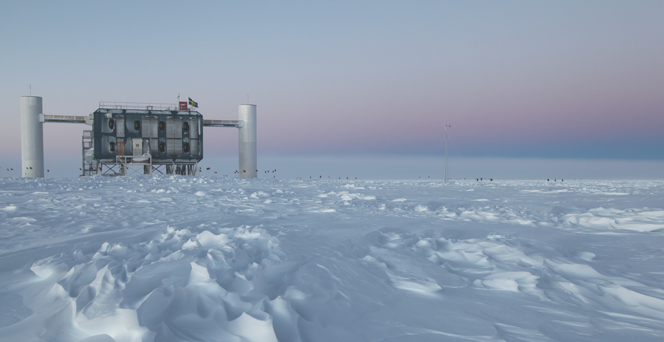URL: https://v1.desy.de/site_www-desy/content/research/facilities__projects/icecube/aufgabenuebersichtsplan_v1_20220131_eng.html/@@siteview
Breadcrumb Navigation

IceCube
Neutrino telescope IceCube
What happens near black holes? What is the origin of the inconceivably energetic particles that shower down on the Earth as cosmic radiation? Scientists get answers to these questions from an unusual telescope in a spectacular location: Buried deeply within the ice of the South Pole, the sensors of the IceCube detector are waiting for neutrinos from outer space – ghostly elementary particles produced by cataclysmic events in the far reaches of the universe. Physicists from the DESY location in Zeuthen are playing a major role in the world’s largest particle detector.
Neutrinos are extremely light particles that pass through everything in their path almost unhindered. This makes them ideal cosmic messengers. That’s because neutrinos reach the Earth on a direct path, coming for example from the centres of distant galaxies, millions or even billions of light-years away. Light beams or gamma rays from these galaxies easily get caught in nebulae on their way to Earth. Charged particles are deflected by cosmic magnetic fields, so that their actual source can no longer be determined. Neutrinos are affected by neither nebulae nor magnetic fields – which is why they can provide us with information from regions of space from where almost no other signal reaches the Earth.
What makes neutrinos ideal cosmic messengers, is also their drawback: They fly through matter so easily that every second, billions of neutrinos pass through every square centimetre of the Earth without leaving a trace. Only very rarely does a neutrino collide with a matter particle. Therefore, gigantic detectors are needed to occasionally observe such a neutrino event.
Particle tracks in the eternal ice
The IceCube neutrino telescope is frozen into the eternal ice of Antarctica – with an enclosed volume of one cubic kilometre, it is the largest particle detector in the world. At a depth of up to 2.5 kilometres, 86 steel cables with more than 5000 light-sensitive detector modules are frozen in the ice. These optical modules observe the tiny blue flashes of light that occur when neutrinos react with the crystal clear ice and thereby produce showers of charged particles. Based on these flashes of light, the flight direction of the neutrinos can be determined. From this, the physicists can in turn reconstruct which regions of space the elusive particles are coming from and where they originated.
As the second largest partner after the University of Wisconsin-Madison (USA), DESY is one of the major players in the international IceCube consortium. A quarter of the IceCube detector modules was produced at DESY in Zeuthen, and DESY is also centrally involved in the development and production of the sensors for the current expansion, the IceCube Upgrade.
First neutrinos from outer space
Most neutrinos that hit the Earth are created in the sun or the Earth’s atmosphere. Far less common are neutrinos that come from outside our solar system. Such extraterrestrial neutrinos are of particular interest because they provide insight into the vast cosmic objects from which they originate: gamma-ray bursts, supernovae, pulsars or the giant particle jets emitted by the supermassive black holes at the heart of active galaxies.
The IceCube collaboration announced its first major breakthrough in 2012. In their measurement data, the researchers identified two events with a tremendous energy of 1000 tera-electronvolts (TeV) – which is significantly more than what is expected for atmospheric neutrinos. Several more high-energy events were spotted in 2013. All the tracks differed so markedly from the atmospheric variant that the implication was clear: IceCube had tracked the first high-energy neutrinos from the depths of space.
Then, in 2017, the first indication as to the particles’ sources was found: A neutrino with particularly high energy was detected from the direction of an active galaxy whose jet points exactly towards Earth. Since then, IceCube has enabled the researchers to gather further evidence of sources of high-energy neutrinos, ranging from our own Milky Way to distant, active galaxies.
The gigantic telescope at the South Pole thus opens up a whole new branch of astronomy. With increasing numbers of high-energy neutrino detections, an upgraded detector and better analysis methods, the scientists hope to identify further sources of high-energy neutrinos in the cosmos.
- Neutrino telescope in the South Pole ice, complemented by a detector field at the ice surface (IceTop)
- Completion: December 2010
- Volume: one cubic kilometre
- Depth in the ice: between 1450 and 2450 metres
- 86 strings with 60 optical modules each
- 5160 optical modules in total


